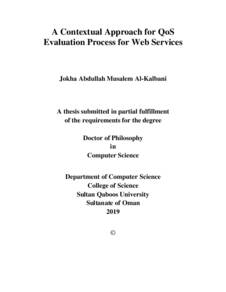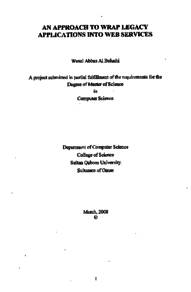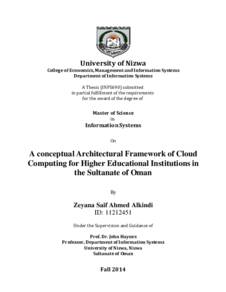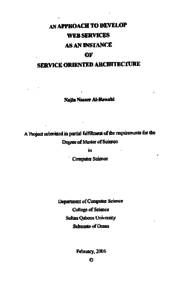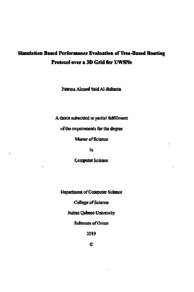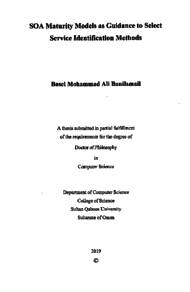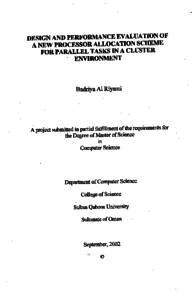وثيقة
A contextual approach for QoS evaluation process for web services
الناشر
Sultan Qaboos University
ميلادي
2019
اللغة
الأنجليزية
الموضوع
الملخص الإنجليزي
In Service Oriented Computing (SOC) paradigm, the entire business functions are viewed as modular, standard-based software services. SOC helps developers to create compound solutions that can be combined with external components located in remote networks. The major innovation in SOC is the move from the object-oriented paradigm to a service- oriented one. Service Oriented Architecture (SOA) is the core of the SOC platform. It is important in SOA to discover the most trustworthy service that best fits for user's requirements. The founded set of candidate services that fulfilled the user's functional requirements are participating in a selection process depends mostly on the Quality of Services (QoS) to invoke the best fit service. With many services available in the distributed environments having similar or even identical functionalities, it is not an easy task for users to select the best web services. Service consumers rely on service providers to ensure that the selected services comply with the agreed QoS. Since QoS information has an important impact on the whole process of web service selection, recommendation and composition, evaluation of this QoS information became a crucial and challenging task to indicate services of different quality factors. In this regard, designing novel QoS evaluation approaches for selecting relevant web services for its requestors has become of substantial importance especially with the increased adoption of web service in industrial and technical communities.
In view of this issue, this thesis aims to contribute to investigating on how to carry out an appropriate and flexible QoS evaluation for web services. First, a framework has been developed as an abstract model to understand the different QoS-related issues for web services. Then, the framework has been used as an analytical study to compare different QoS models of existingQoS evaluation approaches. The comparative study outcomes have been used to come up with the research issues. Second, a new contextual approach for QoS evaluation for web services has been proposed as an effort to reengineer the QoS evaluation process for web services. The objective of the proposed approach is to support QoS evaluation process for web services with the following features: 1) Adaptable to the current context to tolerate different factors affecting the actual QoS evaluation situation i.e. flexible. 2) Provide guidance on how to conduct the QoS evaluation process depending on the characteristics of a given situation. 3) Covers the main aspects of the QoS evaluation process for web services. 4) Collaborative to ease the prediction or computation of QoS values.
المجموعة
URL المصدر
الملخص العربي
في نموذج الحوسبة الخدمية (SOC)، يتم النظر إلى وظائف الأعمال بأكملها على أنها خدمات برمجية قياسية تستند إلى معايير تساعد الحوسبة الخدمية المطورين على إنشاء حلول مزكية يمكن دمجها مع المكونات الخارجية الموجودة في الشبكات البعيدة، وقد قدمت الحوسبة الخدمية ابتكارا جديدا في هندسة البرمجيات من خلال استخدام اسلوب يعتمد على الخدمات بدلا من الأشياء. وتعتبر البنية الخدمية (SO4) هي جوهر الحوسبة الخدمية من أهم الأمور التي يجب مراعاتها في البنية الخدمية هو اكتشاف الخدمة الأكثر موثوقية بحيت تتاسب متطلبات المستخدم. تشارك مجموعة الخدمات الأساسية المرشحة و التي تفي بمتطلبات المستخدم الوظيفية في عملية اختيار معتمدة في أغلب الأحيان على جودة الخدمة (QoS) لاستدعاء أفضل خدمة مناسبة مع توفر العديد من الخدمات في البيئات الموزعة التي لها وظائف مماثلة أو حتى متطابقة، فانه ليس من السهل على المستخدمين اختيار أفضل خدمات الويب. يعتمد مستهلكو الخدمة على مقدمي الخدمات لضمان أمنتال الخدمات المختارة الجودة الخدمة المتفق عليها توتر معلومات جودة الخدمة بشكل كبير على عملية اختيار ختمة الويب والتوصية والتركيب، فقد أصبح تقييم هذه المعلومات مهمة حاسمة وصعبة للإشارة إلى عوامل نوعية مختلفة للخدمات. وفي هذا الصدد، فانه من الضروري تصميم لهج جديدة لتقييم جودة الخدمة من اجل اختيار خدمات الويب ذات الصلة لمقدمي الطلبات خاصة مع زيادة اعتماد خدمات الويب في المجتمعات الصناعية و التقنية وانطلاقا مما سبق، تهدف هذه الدراسة إلى المساهمة في البحث عن كيفية تنفيذ تقييم جودة الخدمة المناسبة والمرنة الخدمات الويب. قدمت هذه الدراسة نتائج مهمة على النحو التالي. أولا، تم تطوير إطار المقارنة نهج تقييم خدمة الويب حيث يمثل الإطار نموذج مجرد لفهم القضايا المختلفة المتعلقة بجودة الخدمة بالنسبة لخدمات الويب. تم ايضا استخدام هذا الإطار كدراسة تحليلية لمقارنة نماذج جودة الخدمة المختلفة تم استخدام نتائج دراسة المقارنة للخروج بقضايا ثانية، تم اقتراح نهج سياقي جديد للتقييم جودة الخدمة في خدمات الويب كجهد لإعادة هندسة عملية تقييم جودة خدمات الويب. ويدعم النهج المقترح عملية تقييم جودة الخدمة في خدمات الويب من خلال توفير الميزات التالية 1. التكيف (المرونة) مع السياق الحالي لتحمل العوامل المختلفة التي تؤثر على حالة التقييم الفعلية لجودة الخدمة 2. تقديم إرشادات بشأن كيفية إجراء عملية تقييم جودة الخدمة اعتمادا على خصائص حالة ما. 3 يغطي الجوانب الرئيسية لعملية تقييم جودة الخدمة 4 التعاونية للتخفيف من التقيؤ وحساب قيم جودة الخدمة.
قالب العنصر
الرسائل والأطروحات الجامعية

